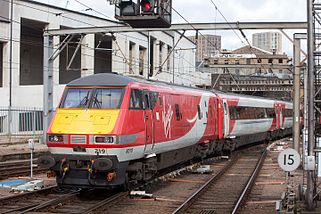East Coast main line
The East Coast Main Line (ECML) is a 393-mile long (632 km)railway link between London and Edinburgh via Peterborough, Doncaster, Wakefield, Leeds, York, Darlington and Newcastle, electrified along the whole route. Services north of Edinburgh to Aberdeen and Inverness use diesel trains. The main franchise on the line is operated by Virgin Trains East Coast.
The route forms a key artery on the eastern side of Great Britain and is broadly paralleled by the A1 trunk road. It links London, the South East and East Anglia, with Yorkshire, the North East Regions and Scotland. It also carries key commuter flows for the north side of London. It is important to the economic health of several areas of England and Scotland. It also handles cross-country, commuter and local passenger services, and carries heavy tonnages of freight traffic.
The ECML forms part of Network Rail's Strategic Route G which comprises six separate lines:
The core part of the route is the main line between King's Cross and Edinburgh, with the Hertford Loop used for local and freight services and the Northern City Line only used on weekdays for inner suburban services.
The route has ELRs ECM1 - ECM9.
The line was built by three railway companies, each serving their own area, but with the intention of linking up to form the through route that became the East Coast Main Line. From north to south they were
When first completed, the GNR made an end-on connection at Askern, famously described by the GNR's chairman as, "a ploughed field four miles north of Doncaster", with the Lancashire and Yorkshire Railway, a short section of which was used to reach the NER at Knottingley. In 1871, the route was shortened - NER opened a direct line which ran from an end-on junction with the GNR, at Shaftholme, just south of Askern to Selby and then (once over Selby bridge on the Leeds- Hull Line) direct to York
...
Wikipedia

